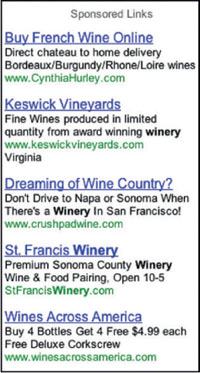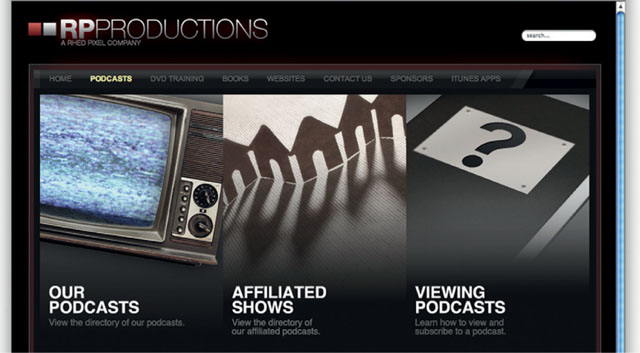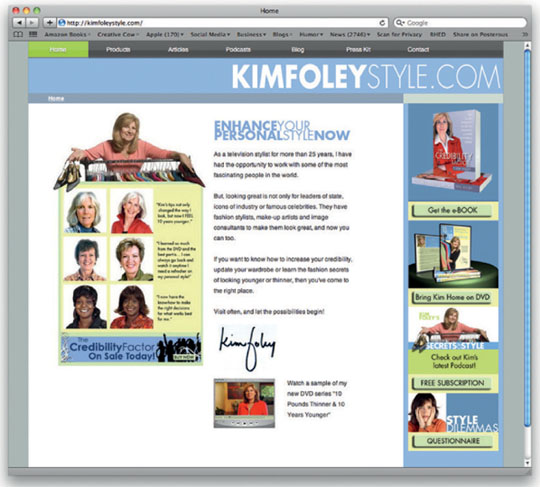MONETIZING YOUR VIDEO
With Paul Vogelzang, executive Producer of MommyCast
Making web video costs money and takes time (and time is directly related to money). As such, you'll need to discover ways to monetize your content. For some, this is easy. Web video can save organizations money when it comes to travel, training seminars, or shipping to customers.
For others, it's not merely enough to spend less money; they need an actual influx of capital. Perhaps the goal is to make enough for the video to fund itself. Maybe it's to generate an extra source of income. Either way, you won't get there overnight.
What we offer here are some starting points. These are proven ways you can monetize your web video content. You'll need to experiment to find which approaches will work for your content.
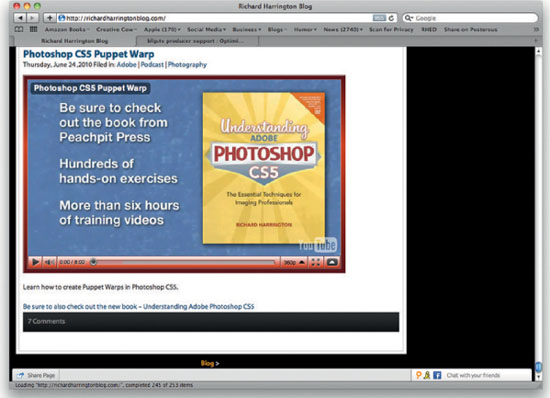
We've learned to be direct with our efforts to monetize web video. In this case, we used a short four-second preroll ad that is also used as a longer postroll. We also put a direct link to a for-sale training product below the video. Social media options also led to comments and tweets about the training.
Potential Revenue Sources
There are many different ways to make a living; the same holds true when it comes to making money from web videos. Essentially you can make money by support of your audience making purchases or from those who want to reach the audience we've built. Many video producers try to employ a mixture of techniques as they find a combination that works for their topic and audience.
Remember, there are two ways to make money, directly or indirectly:
- Direct. This is the closest model to traditional entertainment and news. In this case, you are trying to turn your viewer-ship into money. This can be for advertisements you sell, paid downloads by your audience, or sponsorships you accept.
- Indirect. This approach can be quite successful in that it lets you leverage your experience as a marketable skill. In other words, you take your experience in producing content for the web and make it a hirable skill. This also works by trying to convert viewers into clients for other services that you sell.
More on Making Money from Podcasting and Web Video
![]()
There are a few sources we respect for ideas on making money from web video:
- Online Media Success Podcast (www.onlinemediasuccess.com)
- Podcasting for Profit (www.leesabarnesbooktour.com)
- Internet Business Mastery (www.internetbusinessmastery.com)
- The Business of Podcasting and New Media (www.paulcolligan.com)
- Podcast Academy: The Business Podcasting Book: Launching, Marketing, and Measuring Your Podcast by Michael Geoghegan, Greg Cangialosi, Ryan Irelan, and Tim Bourquin
Affiliate Revenue
One of the easiest financial models to participate in is affiliate programs. In this case, you can choose to promote or mention particular products (such as technology, books, film, or music). In theory, your audience may want to purchase these items after seeing you use them (or hearing your opinions). Some take a direct approach and link right to products and services, while others have a support or site button.
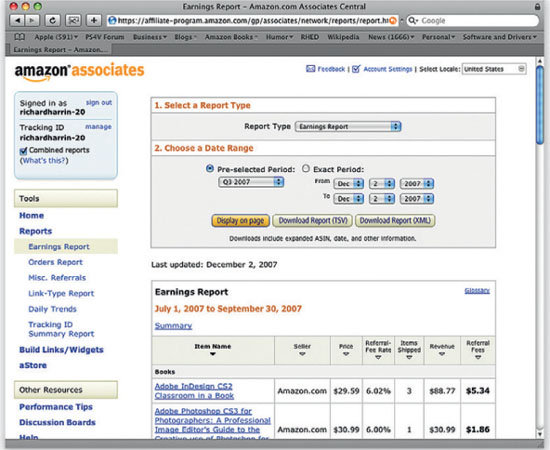
The number one online retailer who has a great deal of products to sell is Amazon.com. If your video has a blog or website, you can provide a list of the featured products. For example, if your podcast talks about a piece of software or a book, and you link to Amazon to buy it, you can get paid. Simply sign up for an Amazon Associates account (affiliate-program.amazon.com). Amazon pays you up to 15% commission on everything you sell as a click-through on your website. Additionally, if someone who clicks through does any other shopping there, you get a percentage of that purchase as well. This is an easy way to bring in revenue that can offset or even cover costs associated with a podcast.
In a move similar to the Amazon Associate model, Apple offers the iTunes Affiliate program. This program lets you create links to a podcast or for-sale item to take visitors to the iTunes Store. You then earn a 5% commission on sales of songs, movies, TV shows, apps, and audiobooks purchased by customers who linked to the iTunes Store from your website. Anything they purchase during the next 24 hours will be credited to your affiliate account. The iTunes Affiliate program is only available in selected countries (www.apple.com/itunes/affiliates).
Advertising
If you have a large viewership, then you can explore ad sponsorship services. There are several in this space, such as YouTube, Podtrac, blip.tv, and Limelight Networks. The rates earned will vary based on your show's subject matter and audience size. Most of these services will sell ads for you and then keep a percentage of the sales.

Many video-sharing sites offer opt-in advertising programs so you can monetize your content.
You can insert AdSense ads into a blog. other services like Youtube also offer advertising revenue sharing for top performers.
You can sell your own ads, which is more work but you keep more money. If you want to seek a sponsor, you'll need to put together a media kit that showcases the strength of your pod-cast and accurately describes its audience (both in size and in demographics). We'll explore this method more in a moment.
None of the podcast directories have an issue with shows that contain ads. On the other hand, many video-sharing sites want to insert their own ads into your program. As a general rule, free hosting means no ads, while paid hosting means it's up to you. We do recommend keeping ads short and to the point. The most effective ads are those that match products or services closely to a video's target audience.
Many video producers choose to place ads on their websites. For some, this takes the form of banner ads from show sponsors. Others take the easier approach of allowing Google AdSense ads into their blogs. These are generally text-only links and can be placed in the sidebar area of a website. An easy way to add these to your blog is by using FeedBurner (www.feedburner.com).
Related Products and Services
For many video creators, there is a reason they publish. Although there is, of course, the desire to create and share, you'll usually find some easy-to-spot motives just below the surface. For example, RHED Pixel has produced several podcasts and web videos through the years. Some of the benefits we've seen (besides ad dollars) include the following:
- Increased opportunities to bid on video production jobs
- Consulting and speaking opportunities
- Increased sales of our books and for-sale training products
- Increased loyalty from existing customers
- Substantial media coverage
All of these factors should be great motivation if you have something to sell. Whether it's products or services, web video can truly raise your profile. It's also an excellent way to engage existing and potential customers in meaningful dialogue.
By creating a landing page for all of our podcasts and web video programs, we can raise awareness for other services and projects.
Working with Sponsors and Advertisers
Making video for the web takes time and money. Ultimately, someone needs to pay those costs. Some create web videos as promotional materials to raise awareness for their causes or efforts. Others take a more direct approach and try to involve sponsors or advertisers in their web videos.
Lining up sponsors or advertisers for your web video can be challenging. Think of it this way: if getting sponsors were easy, every person who wanted to get his or her show on television would be successful. This method is not for everyone, but it can work quite well for certain video producers.
Monetization
Some video creators see monetization as a bad word. They fear giving over control of their show and simply becoming a mouthpiece. These concerns are valid, as many podcasters and video creators we know have felt pressure to give favorable reviews.
When done correctly, however, monetization can allow you to receive the important funding that you need to cover costs. The important step is to establish editorial independence from sponsors and clearly spell out what sponsors or advertisers will receive for their money.
“Partnering with sponsors is vital to the success of our show, and expenses such as hosting, bandwidth, editing, equipment, and marketing are not inexpensive,” said Paul Vogelzang (executive producer of MommyCast).
“Our method of sponsor inclusion is to offer ‘host information and recommendation,’ as well as logo placement on our sites. We never promise favorable reviews, but honest opinions from our hosts, thereby ensuring the passion that our audience demands.”
Sponsorship versus Advertising Models
Understanding the difference between advertising and sponsorship is important. Under the advertising model, commercials are inserted into the web video. This can take the form of pre- or postroll advertisements (much like you'd see in a television broadcast). Many web video players also support the use of embedded or overlaid advertising. These ads can provide hyperlinks that encourage a viewer to click a text or graphic link to visit another website (hence leaving your show in the middle).
Sponsorship, on the other hand, takes the form of financial support given toward a program that is identified and perhaps integrated into the show. This form tends to be a little subtler to the viewer, as it often takes an integrated approach. It can impact the choice of guests, it can take the form of relevant information covered, or it can even affect a video's topic.
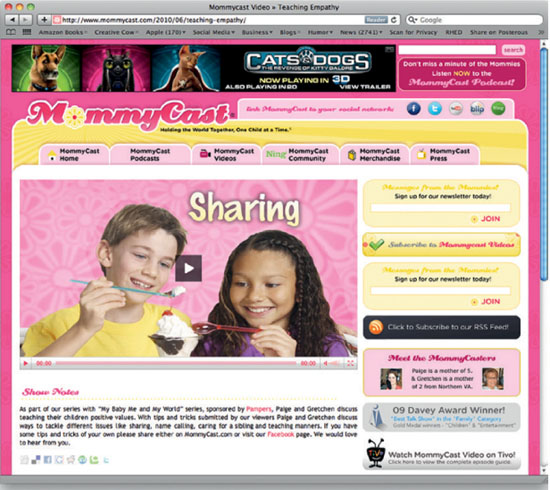
MommyCast successfully uses the sponsorship model for its video content and integrates display ads on its website.
On the other hand, sponsorship can also take a fairly hands-off approach. In this case, the “Public Broadcasting” model is often followed, where sponsors are recognized and thanked but have little input on the show or its content. This is the model that is employed by several top podcasters.
“Sponsorship, as opposed to advertising, will let us pay us, and all other expenses, keeping the show moving forward but allowing for the independence we insist on to remain relevant to our audience,” said Vogelzang.
This editorial separation is important, as it preserves a genuineness that is essential for web video.
Your Case for Sponsors

Lining up a sponsor takes far more than just a great idea. Most shows never get sponsors (at least in the traditional advertiser sense). Even successful shows need to be able to explain their impact in a way that traditional advertisers or sponsors can understand. We've experienced firsthand the frustration of trying to explain the value of web video to sponsors. Many are simply more comfortable going with magazine advertisements or the pay-per-click banner ads that they're used to buying.
“Sponsors today are becoming more and more interested in proving the value of advertising. We spend a lot of time with sponsors who want to know the total number of viewers,” said Vogelzang. “They also want to know what level of engagement is there. Is there sharing that goes on… is there any way that you can quantify your listenership.”
He added, “We've been able to provide value to companies so that they have proof that they are connecting with people… but not going over the line and becoming an infomercial.”
Vogelzang has suggested that you offer the following items to potential sponsors:
- Show description. Offer a clear description of what your video or series covers. Describe the type of content you produce and who you are trying to reach. This description needs to be unique and clear. For example, here is the description MommyCast uses:
We are MommyCast! We are moms immersed in the fullness of life. We are experienced, confident, and interesting… and made so by our families, and the chance to reach out to busy moms everywhere. Millions of women and moms are entering a new age of boundless communications possibilities, and one show is their voice. MommyCast!
- Viewer statistics. You're going to need to provide accurate numbers about your total number of downloads and streaming views. As we discussed in the previous chapter, some of the hyper-syndication services can help aggregate your numbers across multiple video-sharing sites. Many hosting companies can also provide detailed and verified viewing statistics. Keeping track of these numbers can be challenging, so we recommend trying to use some of the aggregator services that will gather statistics.
- Website statistics. Many sponsors only understand website views. As such, you'll want to track the stickiness of your website. We highly recommend using a blog engine to power your website. The use of RSS feeds can increase the total readership for entries and embedded videos. You can also use social media outlets to help with syndication and sharing of content.
- Audience surveys. Because web video and podcasting is so new, we often recommend selling the quality of the audience rather than the quantity. If you sell high-end bags for digital cameras, what's more effective? Advertising in a mass-market magazine that has 500,000 subscribers or sponsoring a video about lighting for digital photography that reaches 5,000 professional photographers? In order to make the distinction, you need to know who's watching.
To attract and satisfy top advertisers like Microsoft, Proctor & Gamble, and State Farm Insurance, MommyCast surveys its audience three to four times per year. For example, those who manage the site can tell you that 54% of the audience has a four-year degree and 29% an advanced degree. MommyCast has also found that the average show is forwarded 34 times to friends and family.
“We send out surveys to our audience. We ask them questions about their lifestyle, about their age, about their income level. We spend a fair bit of time surveying,” said Vogelzang, “about four times per year. Our audience is interested in participating because they know that what we create costs money to make and they want to help us.”
- Media kit. The media kit should clearly package the preceding information for potential sponsors and advertisers. The goal is to make it easy for those who need the information to browse it. This material should include relevant information about the show (but often excludes rates). Be sure to also summarize key information about your audience and videos. This material should be laid out in a publishing application and posted as a PDF to your website.
Identifying and Approaching Sponsors
Approaching sponsors can be a challenge as web video advertising or sponsorship is often handled by very different groups within an organization. One of the easiest groups to target is made up of those that are already advertising. Look at top-rated content that is similar to your genre or web series. Who is advertising in that space already?
Once you've identified who is already in the web video market, an equal (if not better) opportunity exists in finding those who are not. Look to see if the competitors of the firms you identified initially are participating. Oftentimes the market leaders with the biggest budgets aren't advertising in web video, whereas smaller, more agile companies are.

© Fotolia.
Paul Vogelzang builds customized presentations to make his case to potential sponsors. He mixes facts about the show with specific details targeted to the client.
Sponsors are going to want to know that you are visible in your market. This is where the media kit and research we discussed earlier really matter. Rankings on charts like iTunes matter. So do YouTube views. Pull up visible accomplishments that less savvy users can understand. Quality can work too. Focus on unique accomplishments, top guests who've appeared, or other things like awards or industry recognition.
Be sure to also bundle up your content so it's easy to see. We've often found ourselves sending preloaded iPods or DVDs to potential sponsors. Although web video may seem perfectly easy to you, we've encountered more than one person holding the purse strings who couldn't figure out how to watch (or hear) video. We've even encountered major sponsors and media firms who've had video-sharing sites blocked to cut down on workers’ “wasting time.”
Once you get your foot in the door, be prepared to make a proposal with your offer. Potential sponsors will want to know about your video series as well as how you plan to incorporate them. You'll also want to demonstrate that you have some metrics for your video series performance and address how you'll measure performance in the future.
Involving Sponsors
There are many ways to involve sponsors that are far more effective than tacking an advertisement on the front or back of your video. We don't recommend that you use all of these methods at once. Rather, mix things up and use the techniques you feel most comfortable with.
- Invite sponsors as guests. Your sponsors often know your subject matter quite well. Consider inviting a knowledgeable expert recommended by your sponsors. Be sure to set some ground rules for the interview or segment. Stress the relationship with your audience and the genuine connection you are trying to create. Podcast and web video audiences tend to be pretty savvy. Make sure you respect the audience, but don't miss out on top experts as well.
- Point to a resource. Many sponsors will have useful information on their websites. Perhaps it's a web tutorial or a free download. It might be a recent report or even a technical white paper. Try to point out genuine content and even reference it on your site or in a video.
- Review a product. Your viewers often like to hear the latest news about products related to your program or topic. Be sure to offer genuine commentary about the products you review. Our personal philosophy is to only recommend products that we'd recommend to a friend or colleague (think 3.5 out of 5 stars or better). If we are asked to review a product that we don't like, we send our comments to the manufacturer with suggestions for improvements. We don't tend to publish those opinions, however.
- Use a product in a video. In the world of film and television, there is definitely a trend to product placement. In this case, sponsors like to see their products in use by a video's host. Be careful to balance the use of product placements and make sure that you believe in the products you recommend.
- Have a giveaway or a contest. People like free stuff. They also like games and contests. Consider having contests around user-generated content, or perhaps a giveaway of free software or products. There are legal requirements for contests, so be sure to work with the sponsor to be compliant with the law. A useful site to learn more about what issues to consider is www.squidoo.com/contest-rules.
- Thank the sponsor in the program. If the host of the video names and thanks a sponsor in the video, it often has a positive effect for the sponsor. Chances are the sponsorship you receive is essential to bringing the content to the viewer. Letting the audience know this can create a halo effect and lead viewers to check out the sponsor's website or products.
- Give sponsors videos for their websites. This is truly a winwin relationship builder. By giving videos to your sponsors, they can get more visitors to their site and increase visitation times. For you, the video creator, you get new potential viewers and increased exposure.

Banner and Click-Through Advertising
One of the most prevalent forms of advertising on the Internet is the banner ad that asks viewers to click through to visit another site. The problem with this approach is that it fails to measure the true strengths of web video: personality and relationships. A banner on a website is much less important than a meaningfully integrated product or the halo effect of sponsoring great content that an audience loves.
Although sponsors are starting to recognize that web video is an effective, highly targeted medium, the ad agencies that represent the sponsors are only comfortable with what they know. Unfortunately, this is display advertising. This is what has been sold in magazines and newspapers for years.
“One of the things we've learned through the sale of banner ads is that every single sponsor demands them,” said Vogelzang. “Most of our viewers subscribe to MommyCast and they get the show via iTunes or another directly, and it's pushed to them onto portable devices or their computers. The banner ads really aren't that meaningful… but they are to our sponsors.”
How do you resolve this dilemma? Make sure that the links you are using for click-through measurement are embedded in multiple places. You can also encourage your viewers to frequent sponsors and mention their support of your program. Ultimately, though, you need to take the high road and attempt to educate your sponsors.
“We sell banner ads because we have to, but it's not the real value. What the sponsor really gets is an integration of their product with our content,” said Vogelzang. “For example, our hosts talking genuinely about Microsoft's parental controls and how they want those controls for their children… that's what's important to our audience. The banner ads are just a value to the advertiser [and not the viewer].”
Ultimately, if you take the sponsorship path, you'll need to keep both parties happy. Be sure to not overwhelm your viewers and also try to mix up the advertisements so your audience doesn't tune out because of repetition.
Selling Your Content
Logic says if something is good, it's worth buying (of course, that theory gets tested all the time). Many video creators are testing that theory and attempting to bring their content directly to their audiences. There are many potential methods here, considering the value of your content.
Many creators have decided that unlimited and free are dangerous words. Instead of keeping their entire library of podcasts or web video freely available, they've taken steps to limit access. The goal is not to drive folks away, just to drive up demand.
Digital Downloads
One method that video creators seek to employ is that of digital downloads. With venues like Apple's iTunes and Amazon.com, it is getting increasingly easier to deliver for-sale digital files. Other creators use private RSS services to limit access for subscribers (check out www.showtaxi.com and www.klicktab.com).
Kim Foley uses her podcast and web video series to drive people to her website. once there, she offers full-length dVd training and e-books.
The challenge with downloadable files is digital rights management (DRM). It is difficult to prevent customers from sharing your files with others who have not paid. The challenge with DRM is the constant balance to make it restrictive enough without punishing those who've made legitimate purchases.
Traditional Media
Many traditional magazines, television shows, and websites license content. You may find some interest in licensing your content to other channels. These arrangements can be for cash up front, but usually they are done under a profit-sharing arrangement. Networks and syndicators are often looking for additional content, which can then have ads sold against it.
Back Episodes
Many podcasters and web video producers look to make money from their catalog of materials. Some do this by bundling back episodes together and selling them on DVD at full quality. Others make back episodes available for sale or through subscription only. The theory here is to keep around 20% of your back episode content available for free and move the rest behind a wall that people pay to get access to.
Exclusive or Expanded Content
Another option is to produce shorter videos and then offer more in-depth materials for sale. Many see web video as a brand builder, something that can be used to pull in new people and sell related products or services. Consider using this approach to take your most loyal fans and make them paying customers. This approach is like a VIP line. The most interested viewers will want your best content—and will likely pay for it.

We've produced advanced training in a longer form for release as an application. We've also included an e-book, quizzes, and hands-on files to increase the value of the content.
Applications
Another solution is the expanding market of applications for mobile devices. Leading the way is the Apple iOS platform. The practice here is bundling applications into functioning apps.
We have firsthand experience in this practice. The challenge to date has been the “race to the bottom” pricing approach that has pushed applications into selling for very low rates (or even free). Fortunately, three recent trends are making this market potentially viable:
- iBooks/eBooks. Devices like the Apple iPad and Amazon Kindle are beginning to support rich media electronic books. This means that video can now be safely embedded into a publication. Apple Pages (part of the iWork suite) makes authoring an iBook file easy.
- iPad applications. The market seems to have learned from earlier mistakes with the iPhone. Video-rich iPad apps have emerged and are sticking to higher prices and offering top video quality.
- App-building services. Creating applications has continued to get easier. Thanks to services like AppMakr and appOmator, nonprogrammers can create their own iPhone-compatible applications. New efforts from Adobe that tie into the inDesign publishing platform are also emerging onto the market.
The Road Ahead
The world of web video and podcasting will continue to evolve at a rapid pace. To keep this book relevant, please keep in touch with us. Visit these sites to keep up with the latest news and information:
- Book's Downloads
- RHED Pixel
- Rich's Blog
- Facebook: RHED Pixel
- Facebook: Richard Harrington
- YouTube


